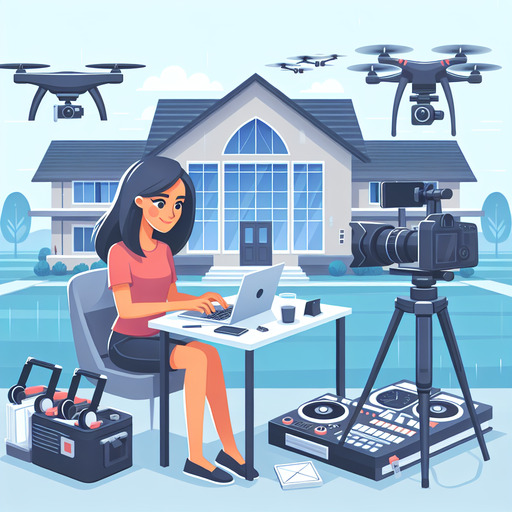
-
Table of Contents
Unlock the potential of your real estate listings with top-notch video production gear! Discover the essential tools you need to create stunning property videos. Learn more here.
Introduction
Real estate video production has become an essential tool for showcasing properties in a dynamic and engaging way. To create high-quality videos that capture the attention of potential buyers, having the right gear is crucial. Essential equipment includes a high-resolution camera, preferably with 4K capabilities, to ensure crisp and clear footage. A variety of lenses, such as wide-angle and zoom lenses, are necessary to capture different perspectives and details of the property. Stabilization tools like gimbals or tripods are vital for smooth, professional-looking shots. Additionally, good lighting equipment, including softboxes and LED panels, helps to illuminate interiors effectively. Drones equipped with high-definition cameras can provide stunning aerial views of the property and its surroundings. Audio equipment, such as external microphones, ensures clear and high-quality sound for voiceovers or on-site commentary. Lastly, video editing software is essential for post-production to enhance the footage, add effects, and create a polished final product. Investing in the right real estate video production gear can significantly elevate the quality of property listings and attract more potential buyers.
Essential Gear for Real Estate Video Production: Cameras, Drones, and Editing Tools
In the realm of real estate marketing, video production has emerged as a powerful tool to captivate potential buyers and showcase properties in their best light. To achieve high-quality real estate videos, having the right gear is essential. This article delves into the essential equipment needed for real estate video production, focusing on cameras, drones, and editing tools.
To begin with, the cornerstone of any video production is the camera. For real estate videos, a camera with high resolution and excellent low-light performance is crucial. Full-frame mirrorless cameras, such as the Sony A7 III or the Canon EOS R, are popular choices among professionals. These cameras offer superior image quality, dynamic range, and versatility, allowing videographers to capture stunning footage in various lighting conditions. Additionally, interchangeable lenses provide the flexibility to shoot wide-angle shots of interiors and detailed close-ups of architectural features.
Transitioning from cameras, another indispensable piece of equipment is the drone. Aerial footage has become a staple in real estate videos, offering a unique perspective that ground-level shots cannot achieve. Drones like the DJI Mavic Air 2 or the DJI Phantom 4 Pro are highly recommended for their ease of use, stability, and high-resolution cameras. These drones can capture sweeping views of the property and its surroundings, providing potential buyers with a comprehensive understanding of the location. Moreover, drones equipped with obstacle avoidance technology ensure safe and smooth flights, minimizing the risk of accidents.
In addition to cameras and drones, stabilization tools play a vital role in producing professional-quality real estate videos. Gimbals, such as the DJI Ronin-S or the Zhiyun Crane 3, are essential for achieving smooth, cinematic shots. These devices counteract unwanted movements and vibrations, allowing videographers to create fluid and stable footage, even when moving through tight spaces or uneven terrain. Furthermore, tripods and monopods are invaluable for static shots, providing a steady base for the camera and enabling precise framing.
Moving on to the post-production phase, editing tools are equally important in crafting compelling real estate videos. Software like Adobe Premiere Pro and Final Cut Pro X are industry standards, offering a wide range of features for editing, color grading, and adding effects. These programs allow videographers to fine-tune their footage, ensuring that the final product is polished and professional. Additionally, incorporating music and voiceovers can enhance the emotional appeal of the video, making it more engaging for viewers.
Moreover, investing in high-quality audio equipment is often overlooked but essential for real estate video production. Clear and crisp audio can significantly enhance the viewing experience, making the video more immersive. Lavalier microphones, such as the Rode Wireless GO, are ideal for capturing clear dialogue during property tours. For ambient sounds and voiceovers, shotgun microphones like the Sennheiser MKE 600 provide excellent audio quality, ensuring that every detail is heard.
In conclusion, producing high-quality real estate videos requires a combination of essential gear, including cameras, drones, stabilization tools, and editing software. By investing in the right equipment, videographers can create visually stunning and engaging content that effectively showcases properties and attracts potential buyers. As the real estate market continues to evolve, staying updated with the latest technology and tools will ensure that your video production remains competitive and impactful.
Q&A
1. **What essential gear do you need for real estate video production?**
– **Camera**: A high-quality DSLR or mirrorless camera with 4K video capability.
– **Lenses**: Wide-angle lens (16-35mm) for capturing entire rooms and spaces.
– **Stabilization**: Gimbal or tripod to ensure smooth and stable footage.
– **Lighting**: Portable LED lights or softboxes to enhance interior lighting.
– **Microphone**: External microphone for clear audio, especially for voiceovers.
– **Drone**: For aerial shots and exterior views of the property.
– **Editing Software**: Professional video editing software like Adobe Premiere Pro or Final Cut Pro.
– **Accessories**: Extra batteries, memory cards, and a camera bag for convenience.